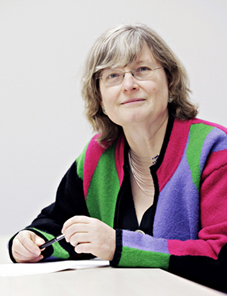Pauli Lectures 2015
The Wolfgang Pauli Lectures 2015 were dedicated to mathematics.
Prof. Ingrid Daubechies
Duke University, Durham, USA

Ingrid Daubechies earned her Ph.D. in theoretical physics from Vrije Universiteit Brussel. In addition to seminal advances in time-frequency analysis, she is best known for her breakthroughs in wavelet research and contributions to digital signal processing. Some of the wavelet bases and other computational techniques she developed were incorporated into the JPEG2000 standard for image compression.
Ingrid’s career has seen many impressive firsts: the first female full professor of mathematics at Princeton; the first woman to receive the National Academy of Sciences Award in Mathematics in 2000; the first woman president of the International Mathematical Union in 2010; and she is very likely the first and only mathematician to have been granted the title of Baroness by Belgium’s King Albert II.
Ingrid continues to break new ground in mathematics research, focusing on signal analysis and inverse problems, with applications ranging from fMRI and geophysics to paleontology and fine art painting.
Mathematicians helping Art Historians and Art Conservators
Monday, October 26, 2015 (20:15 h) Auditorium Maximum, HG F 30
In recent years, mathematical algorithms have helped art historians and art conservators putting together the thousands of fragments into which an unfortunate WWII bombing destroyed world famous frescos by Mantegna, decide that certain paintings by masters were “roll mates” (their canvases were cut from the same bolt), virtually remove artifacts in preparation for a restoration campaign, get more insight into paintings hidden underneath a visible one,…
The presentation will review these applications, and give a glimpse into the mathematical aspects that make this possible.
Lovely Bones: a Meeting of Mathematical and Biological Minds
Tuesday, October 27, 2015 (20:15 h) Auditorium Maximum, HG F 30
The talk will present mathematical explorations motivated by the need of biological morphologists to compare different phenotypical structures. At present, scientists using physical traits to study evolutionary relationships among living and extinct animals analyze data extracted from carefully defined anatomical correspondence points (landmarks). Identifying and recording these landmarks is time consuming and can be done accurately only by trained morphologists. This necessity renders these studies inaccessible to non-morphologists and causes phenomics to lag behind genomics in elucidating evolutionary patterns.
Unlike other algorithms presented for morphological correspondences, the approach presented in the talk does not require any preliminary marking of special features or landmarks by the user. It also differs from other seminal work in computational geometry in that the algorithms are polynomial in nature and thus faster, making pairwise comparisons feasible for significantly larger numbers of digitized surfaces.
This approach has already been used by biologists to obtain new results.
And there are many further avenues to be explored!
Surfing with Wavelets
Thursday, October 29, 2015 (20:15 h) Auditorium Maximum, HG F 30
Via internet we can download images from all over the world. Most of these are compressed in some way, to make the transmission and storage more efficient. Mathematics plays an important role in these compression techniques, which we shall explore in the lecture.